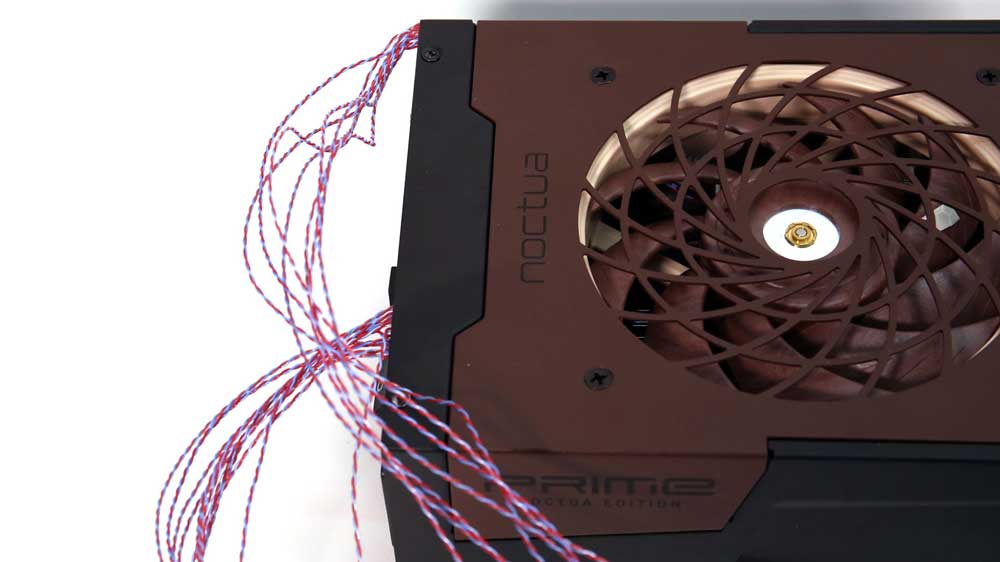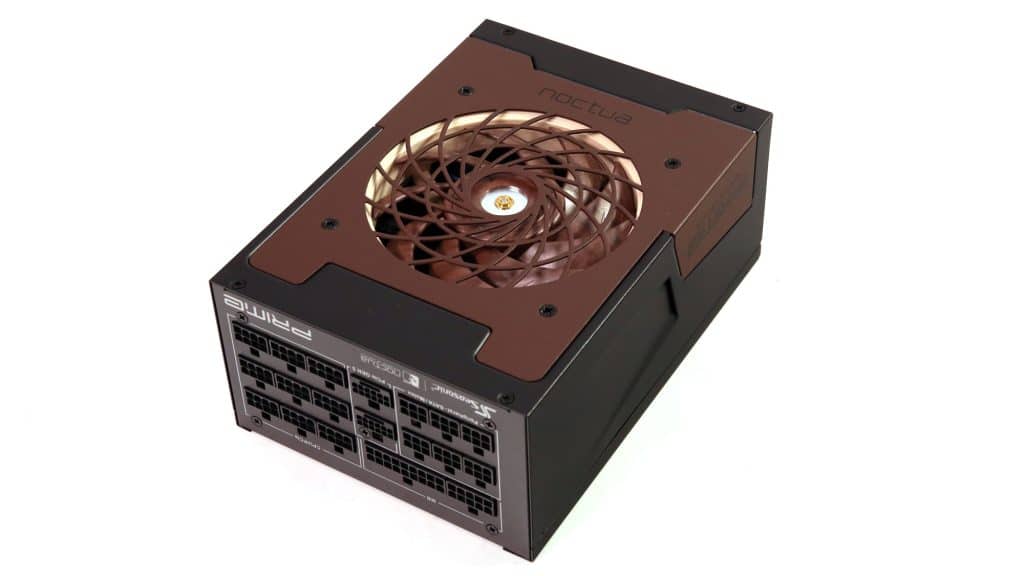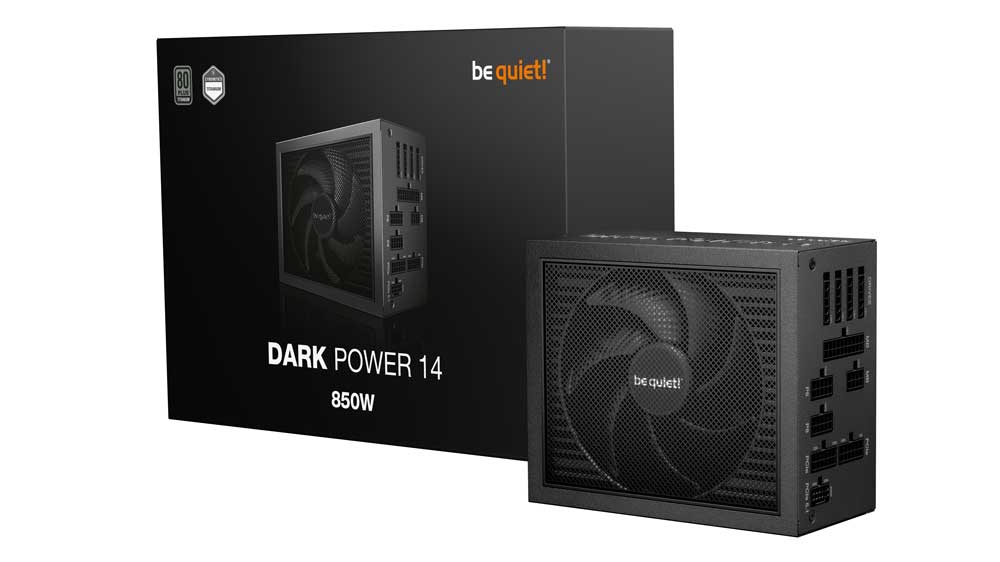Epilogue
The change of fan and its top cover in the Noctua Edition TX-1600 brings a notable improvement only to the main transformer because the smaller fan focuses its airflow in this region. Still, the PFC FETs have notably higher temperatures, reaching close to 100 ℃ with the input voltage steady at 115V, which won’t be the case in real-life scenarios with the PSU at full load because there will be a notable voltage drop on the AC socket. This makes me worry that there might be issues with the fan change only under extremely stressful scenarios, and a beefier heatsink is required for the APFC FETs and parts of the PSU where the smaller fan provides lesser airflow. When you design a PSU and offer a 12-year warranty, you must be prepared for the worst-case scenario, not the ideal one.
Moreover, the heatsink cooling off the 12V FETs gets notably hotter in the Noctua Edition unit. I couldn’t measure the 12V FETs directly without affecting the heatsink’s work, but having a close to 10.5% increase in temperature at 115V input (and 9.5% at 230V) is not a good sign. The same rise in temperature is also evident in the VRMs generating the minor rails.
The smaller fan in the Noctua Edition PSU tightens the airflow to a specific region in the PSU, improving it in this region, which is not so important since the main transformer can handle the heat and operate without issues, even at high temperatures. At the same time, parts like MOSFETs have lower temperature limits and are generally more sensitive to high operating temperatures. Given the 12-year-long warranty in both TX-1600 editions, I would go for the “plain” TX-1600 despite the higher noise output under stressful conditions. Always keep in mind that lowering the noise output comes at a cost when you don’t use larger heatsinks, which cost more, and there is also the tooling and re-design cost that should be considered.
Another thing that bothers me about the Noctua Edition unit is the notably lower 12V rail voltage level compared to the “original” TX-1600. I cannot explain why this happened and the purpose of lowering this rail in the NE unit. The review sample I tested a while ago didn’t drop below 12V, even at 110% load at 46.7°C.
To answer the article’s title, whether the Noctua Edition TX-1600 is reliable. In the short period (1 hour), I applied full load at 115V, and at 50C, it didn’t fail; this is a good sign, but according to the PSU’s specs, it is supposed to be able to deliver a full load at such high temperature indefinitely. Still, I noticed notably higher temperatures in sensitive parts (APFC converter, 12V FETs, minor rails VRMs). This powerful PSU is supported by an extended warranty and is destined for high-end systems with energy-hungry components. I cannot know how users will treat it and how it will fare in the long run. I would feel safer with the “original” TX-1600. The Hong Hua fan used in the TX-1600 has almost double the airflow of the Noctua fan, which matters the most in a PSU and has notably higher static pressure.
| Performance Factor | NF-A12x25 PWM High-Speed Edition | HA13525H12F-Z (0.5A) |
| Max Speed (RPM) | 2469 | 2315 |
| Max Airflow (CFM) | 64.64 | 120.34 |
| Max Static Pressure (mmAq) | 2.91 | 3.58 |
| Max Fan Noise Level (dBA) | 35.40 | 41.60 |
| Cybenetics Reports | Cybenetics Evaluation Report | Cybenetics Evaluation Report |
I should note that both samples tested in this review were NOT provided by either Seasonic or Noctua but bought from the market.
Before investing in a new power supply, read my Best ATX v3.x PSUs article to check all alternative PSU offerings. You help me a lot by using my affiliate links, which don’t increase the product’s price. I get a commission from Amazon every time you do it, which can make a difference for me, especially now that I am on my own, working exclusively for my media and not for someone else.




@Slim_Thug
1 minute ago (edited)
http://www.youtube.com/@HardwareBusters
I ordered a workstation setup that I put together.
One of the components is Astral 5090.
The second one is Seasonic Prime TX-1600W Titanium Noctua Edition which has 3.1 ATX and 5.1 PCIe.
Someone mentioned to me that Asus ROG Thor Titanium III 1600W has Voltage Stabilizer and GPU-first function.
Does this thing actually work, does it distribute evenly, does it solve the problem so my GPU wouldn’t be in danger of melting?
I really hope You answer at all and with a good one because I am waiting on my order which arrives at the beginning of march.
Someone had bought the Thor III and if it really helps then I have to hope that it comes back in stock so I can switch it out.
I would advise against the Thor unit because its platform has issues when/if operating at low voltage input.
Thank You
As usual noctua’s “secret” to low noise is…..low airflow!!! Useless
I got this PSU and have until 2/21 to return it on amazon. I plan on having a 5090 gpu and 9800x3d cpu. Should I be concerned about reliability? I live in the states (Iowa), my other option would have been Lian Li 1300 psu or the NZXT (I don’t really like NZXT’s cables). Should I switch PSU’s?
I also have until the end of the month to return mine… Was going to do exactly the same as you. But these reports got me worried and now I don’t know if I should return or not…
thinking I’ll return it if I don’t see an answer by next week and go with the other 2 options. I’d rather not take a risk on the psu.
Hello,
will there be a test of the new ASUS ROG Thor Titanium III 1600W in the near future and is this PSU better than the Seasonic Prime TX-1600?
yes if you’re getting an asus 5090 astral so it can do load balancing and hopefully ur house won’t catch on fire.
I got the PRIME TX ATX 3.1 1600 watt , not Noctua , but also notice 12v is 11.84 from MB reading , out of the the PC , used DR Power III to check , it was 12.3v for the CPU and 12v2x6 was 12.2v , also used WireView for the 4090 11.999 to 12.0 rock steady , software reading from the MB is a waste of time .
Seasonic Support Desk
You
Dear Harmon,
Thank you for your reply.
The PSU is ATX 3.1 and PCIe 5.1. Intel simplified the naming of ATX 3.1 to ATX 3 and PCIe 5 to avoid confusion. Therefore, our PRIME TX-1600, which follows ATX 3.1 and PCIe 5.1 standards, will include the 12V-2×6 cable and connector on the PSU side. You can check the connector on the PSU; it should have shorter sense wires and longer power pins. The packaging will also feature a 12V-2×6 logo to differentiate it from previous ATX 3.0 and PCIe 5.0 (12VHPWR) versions.
If you have any other questions, please let us know.
Thank you.
Do not take seriously the mainboard volt readings. they are totally unreliable. Use a cheap multimeter instead.
Aris would you review Gamemax GX-1050 Pro ?
Just my luck. Pulled the trigger a few days ago on one Noctua Edition PSU after spending loads of time reading through reviews and checking the lists.
I am still well within the return period, in your opinion, would this be a reason to to return the PSU and choose another model? I am on 240v.
Thank you so much for all the wonderful analysis and reviews you make, they are extremely helpful.
I just measured the rails on my Noctua Edition PSU with a Fluke multimeter and I get 12,16v readings on the 12v rail. Is the problem with the lower 12v rail only when there is load applied?
Really good article as always Aris, just one comment. You cannot use percentage values to quantify the differences between two temperatures taken in Celsius degrees; you have to use absolute values instead.
Good point – you *could* compare percentages based on delta over ambient.
For example, taking the PFC MOS #1 measurements in the 115V test:
* TX-1600: 35.36 °C over ambient
* TX-1600 NE: 43.78 °C over ambient
* Delta: 8.42 °C, 23.81%
Yes, I can also use Delta, but why can I not use percentages to provide the difference more intuitively? Is there any literature for this?
Hi Aris, let me rephrase what I said in a more long winded answer.
It’s not that it’s not possible to express the difference between two readings in Celsius or Fahrenheit as percentages, but it’s more than those two types of units work in a “relative scale and not an absolute scale” (from Wikipedia). That is, Celsius only measures stuff relative to the boilling and freezing points of water at 1 atmosphere. That’s unlike something like Kelvin or Rankine units, the former of which is described by the US National Institute Of Standards and Technology as an “absolute unit” because it measures the “average energy of motion (kinetic energy) [an object’s] atoms and molecules have”. As such, the percentual difference between two readings done at Kelvin and Rankine describe the change of kinetic energy between two objects. Based on my understanding, I could only describe the percentage difference between two readings done in Celsius as how much the thermometer readings changed, which is a pretty weird usage when a Celsius reading is on itself an already straight-forward way to understand temperature. Using percentages is only making things more complicated!
With that said, I’m not saying that Hardware Busters should now measure everything in Kelvin just so that we can present temperature deltas as percentages. It’s especially silly when the temperature of air and water cooled PC components never goes below ambient temperature .It’s just that based on what I mentioned above, a percentage difference is very rarely used when comparing two Celsius readings. I can recall that Steve from Gamers Nexus has said a similar thing in camera (he probably said something along the lines of “You cannot use percentage values to quantify the differences between two temperatures taken in Celsius degrees; you have to use absolute values instead”, which admittedly was my viewpoint before I actually done some research to write my answer lol), and I imagine it’s a similar reason why I can’t ever recall seeing this on other competing tech sites (including Anandtech, Tom’s Hardware, Techpowerup, etc.) and on other contexts for that matter (like weather forecasts). And talking about weather forecast, I found a post on ResearchGate that mentioned this exact issue, and there’s an answer posted by someone called “Peter Urich” that includes a response from a chief meteorologist at WGN-TV that mentions similar points to what I said at the beginning of my answer. I’ll link you with the URL: https://www.researchgate.net/post/Percentage-change-in-temperature-in-future-climate-condition
Even if I’m no physicist, I just find it more straightforward to represent those differences as an absolute value instead, which is what’s already used in most tech websites.
Cheers!
Got it, thanks! But given my academia background, I still see nothing against using percentages apart from the fact that some users might get confused. These big sites, I used to write for them too, Tom’s and TPU, and the fact that they don’t use percentages doesn’t mean anything to mean I am afraid, since they are not the “standard”. The “standard” for me is what you know personally and your studies and research in the field and I have a strong background there that I trust to guide me. This doesn’t mean of course that I will be right on all cases.
But please we should not confuse what is “not right” with what can be confusing. Using percentages for temperature readings might not be common but it is not wrong either. Now if I did that in dBA which is a logarithmic scale it would be wrong for sure, but temperature is NOT logarithmic but linear. It is just that the Fahrenheit and Celsius scales are a fraction of the whole range.
I agree with the other two commenters, that using percentages here is not great. If I have to stop and ask or think about 5% relative to what then I think you can do better at communication. I had to quickly calculate what the percentages meant here. There is an unspoken assumption that 0 is the start of the scale here. Even without using that assumption lets say we were going to compare the base psu with a special version. Would measuring two values 100C and 0C really be 100% better cooling? Does it even make sense? This approach can give numbers that start to lose meaning quickly. What the reader wants to really know is if they used both power supplies about how much cooler would it be in degrees delta.
I’d say a percentage really only works if we were able to compare heat transfer rates/efficiencies.
It’s essentially the same reason that when showing a graph, it’s often seen as misleading to put the minimum value at something other than 0. An example that’s commonly used to illustrate this is charts of average height (of a human) by country, if you draw in silhouettes of humans instead of bars (but don’t start the “feet” at 0 but something higher like 1 meter).
But I think it’s reasonable to use percentages when using difference over ambient temperature, because that’s also an effective 0 (the point of thermal equilibrium). IIRC thermal energy also scales linearly with temperature so you can say it’s x% worse at dissipating thermal energy (but don’t quote me on that).
Good review. Thank you crmaris!
Ugh, they messed it up with noctua edition.. Great article!
even on 230V the fan is running over 1200(sic!) RPM faster than acceptable
if put under serious load this PSU would be louder than graphic cards, not a great experience
also, while many of PSU use special 135mm fans using a 140mm one should be possible, A14x25 anyone?
It would be possible, but more difficult, since the side plates would have to have holes cut out, since 140mm width of PSU is given by the standard. In 150x140x86 PSU with the NF-A14x25r G2 it could look like this: https://imgur.com/xFs5L9R
yeah, I guess all the 140mm fans used in power supplies are ones without the standard frame, a collab on a product like this should be able to pull it off, but not this time